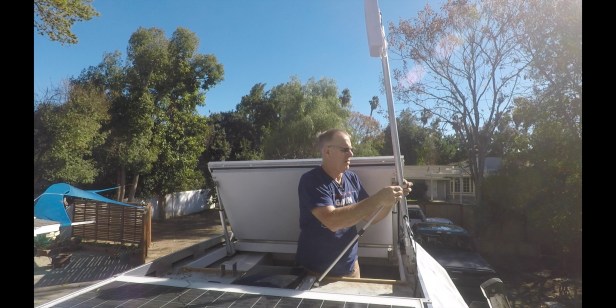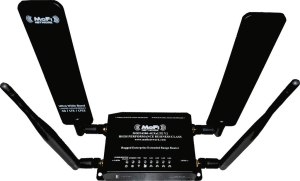One of the biggest struggles for anyone traveling is internet access. Being in a mobile tiny house like Maximus is no exception. When we put together goals for our camper upgrades one of our priorities was to improve the internet access. We had an LTE Router but no cell plan for it. Also, we wanted to add an external antenna. Based on using just cell phones and previously just the LTE router with it’s included 5dbi paddle antennas, we knew that the signal’s we could get into the camper was insufficient.

Our Old and Very Useable LTE Router

Our Old and Very Useable LTE Router
We purchased 3 years ago a MoFi 4500. I consider it old but it is still available on the market for $329.00. We last used it with a Google Fi tablet SIM which worked sometimes well enough and other times, not so well.
This router has only 1 SIM slot and does not support Bands 66 and 71 nor any 5G bands. Currently there’s both an upgrade to this version that does support bands 66 and 71 plus there’s a model MoFi 5500 that has more capabilities. Although it’s old, we know it’ll function and decided to keep using it. It’ll provide enough performance and someday when it doesn’t we’ll upgrade. There are many LTE router solutions out there and you’ll find plenty of recommendations for the Nighthawk by Netgear or PepWave and other devices. If you’re in the market, a little reading of reviews and forums is needed to determine which unit to settle on.
Data Plan
We knew we needed to migrate to a 2nd carrier. Both the cell phones are on T-Mobile so that left a Verizon network or AT&T network provider. After much digging and comparing, the two options that I felt worth pursuing were the Visible Party Plans and AT&T Tablet plans. Both would have net monthly costs of approximately $25.00.
The scales tipped in favor of the AT&T plans when I uncovered an Unlimited Tablet Plan for $20/mo + taxes being talked about in a Facebook LTE 5G Hacks Group. I continued to read through posts and see what issues folks had with either carrier’s plans. With little risk other than the activation fee, I proceeded to get the AT&T setup in place. If you want more information on this specific plan, feel free to check out this link https:\\cellularinternet.info. This was a key resource for me in understanding the current plans in our market and determining which would be a good option.
External Antenna
Antenna solutions vary greatly but I knew we were looking for a 2×2 MiMo capable solution. But which type of antenna?
- Directional or Omnidirectional?
- Log periodic or flat panel?
- What dbi value would be best?
- Does it support the bands my carrier and router need?
- How will it mount onto the roof?
- How will we raise it up and aim it?
For us it really came down to what will fit onto the camper seamlessly and still provide a decent level of performance gain. Reviewing the sizes, shapes, and mounting requirements of these various types of antennas, we determined a flat panel 2×2 MiMo would be the better fit for our roof. It’ll stow well and we can connect it to the MoFi with the shortest amount of cable need.
- Where purchased: waveform.com
- Cost: $99 (antenna only) or $199 as a full kit
Waveform’s website also has some great write ups which I used as additional resource material before deciding on the type of antenna. Based on reviews, they offer good support if you were to call them and ask for assistance to put together a solution.
Another company that came highly recommended to me was Wireless Haven. They support a wide range of products and the rural LTE internet solutions. The learning center is fully loaded with educational materials to help you build a system.
Cabling and Installation for Maximus’ new Antenna

Parts List
Here’s a list of what we used for cables and connectors to connection our new antenna to the MoFi router. Waveform’s site does offer a kit which includes both the antenna mount and 30′ of cabling. The mount for us needed to be custom and 30′ isn’t necessary for most RV installs. It’s preferable to use as little cable as possible to prevent signal loss.
- Exterior cable: 2 x 10′ KM R240 (outdoor rated) 50 Ohm cables with N type male (@antenna) and SMA-male (@ roof access) ($18/each)
- Interior cable: 2 x 3′ RG316, 50 Ohm cables with SMA Female bulkhead (@ roof access) and SMA-Male (@ Mofi Router) ($8/each)
- Antenna: RSRF 2×2 MiMo Cross Polarized Panel Antenna ($99)
- LTE Router: MoFi 4500 SIM4 is what we currently are using; the updated model is a MOFI4500-4GXeLTE-SIM7-COMBO which does support the higher bands 66 and 71 for AT&T and T-Mobile.
- Mast: 5′ long 1.5″ diameter x 1/16ths thick aluminum tube (approximately 1.752 lbs @ $2.70/lb = $4.73)
- Additional aluminum material was from the shop scraps/inventory
Our interior cable was already installed and has been in use from our old Lance camper. The router was installed under a cabinet and we relocated the paddle antennas from the router to (1) move them out of the way and (2) move them up higher on the roof.
Note: If you are not aware of how connector genders are specified, read this before purchasing cables with connectors.
Connector genders are specified by the (center), current-carrying, contact pin. A ‘straight polarity’ connector (most common) has opposite contact/coupler genders. A ‘male’ connector will have a male contact pin and a female, internally threaded, nut-style coupler. A ‘female’ connector will have a female contact socket and an externally threaded male coupler.
Also, be careful of ‘reverse polarity’ types. SMA connectors are commonly available in ‘reverse polarity'(RP). Reverse and straight polarity connectors WILL NOT CONNECT TO EACH OTHER. RP connectors have male pins in male couplers and female sockets in female nuts. They are described with ‘RP’ in the connector description (Ex. straight polarity is ‘SMA-F’, reverse polarity is ‘SMA-F-RP’)
Costs for Raising Our Internet Performance
Because we decided to continue utilizing the older MoFi 4500 model as our LTE, our net cost for just the antenna install was approximately $140 + taxes.
Our data plan is $50+ taxes to start and then $20+taxes per month. This will cost us maybe $100 just to have it in place when we’re not traveling. For the $240/yearly fee we decided it was worth locking on to the plan even if we’re not using it every month. This of course will be in addition to our current T-Mobile phone plans.
Video
We include more antenna setup and deploy details and even test results in our youtube video. Check it out!

Wow, the things we have to do to stay connected while traveling, Cheryl! This was so interesting to read, glad you found a solution! We knew we were moving to rural internet land and have struggled for a whole year. Thankfully we both had Verizon as our cell carrier (I started when they were Airtouch cellular 26 years ago–believe me when I play that card at the Verizon store or when I need assistance). Where we live, Verizon is the ONLY way to use data which I did for 2-3 months after negotiating a new data plan. Each time a new neighbor moves into our subdivision we all ask each other if they have Verizon. LOL. Although our subdivision was wired for fiber internet (one of the first in rural WA), it took a year to get it going, which I can thankfully report, we were LIVE Friday. Trust me when I tell you I had too much champagne with my neighbors and the fiber manager who stopped by to check things out (his pet project), then spent the entire evening with my hubby streaming Netflix which we haven’t been able to do for 14 months. I will have to look into wifi if we travel more. Your post is very helpful, and bookmarking for reference!
LikeLiked by 1 person
It’s been quite an education figuring out what we think is the optimum setup for roaming around the country. I’ve been so spoiled all my life being in suburbia, that discovering everyone actually didn’t have good internet and what they do to solve it has been very interesting. Rural internet has been such a weak infrastructure for years; seems only recently that there are more options using LTE routers and antennas to at least get a reasonable amount of speed for home life. Starlink will be interesting to watch as well. We’re not on the list, but thinking if we had it and could use at home and one the road, it maybe the way to merge our needs into one expense. When we eventually move ourselves out in the sticks, we’ll be reassessing again, based on what’s available and how much it costs.
For the RV side, if we do end up with only verizon, we’ll be in a black hole. We’re ok with that for now. We also travel quite a bit where there are no towers and will expect to be disconnected; which is a good thing in moderation.
I added the YT video link to the post now; repeats some of the same info but also adds more info for the camper and our first test run.
LikeLiked by 1 person